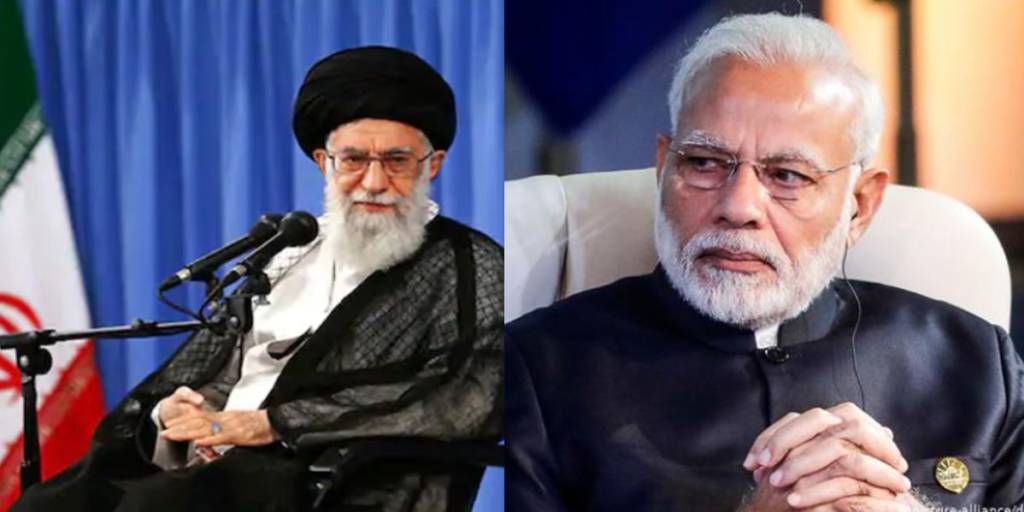Iran is troubled deeply with American and Western sanctions. Not only is the Iranian economy passing through troubled waters, but an increasingly insecure Tehran also feels that owing to its pivot towards the US, New Delhi is not doing enough to help a sanctions-ravaged Iranian economy. India, for example, used to be the second biggest importer of Iranian oil in the world. But after US sanctions on Iran, Tehran has lost the prolific oil-purchaser.
Therefore, Iran’s Supreme Leader has come up with a rather desperate step- a Hindi Twitter handle. The handle has no real diplomatic purpose to serve, rather it looks like an attempt to exert Shiite supremacy and provoke sectarianism. This is a subtle attempt by the Iranian Supreme Leader, Ayatollah Khamenei that New Delhi shouldn’t take Tehran for granted.
Khamenei’s Hindi Twitter handle has just two tweets, both of them aimed at religious messaging. Moreover, he is not following anyone from his Hindi handle, clearly showing that this is not a diplomatic exercise. The content of the tweets is however the real issue.
On August 8, that is, the occasion of Eid al-Ghadir, Ayatollah tweeted in Hindi, “Although, we Shias have a strong connection with the event of Ghadir, the fact is that the event of Ghadir is not limited to the Shiites in terms of its factual matrix and the real essence of Islam, but also related to the entire Islamic world. Because the event of Ghadir is founded upon the real soul of Islam.”
हालांकि ग़दीर की घटना से हम शीयों का हार्दिक रिश्ता बहुत मज़बूत है लेकिन हक़ीक़त यह है कि ग़दीर की घटना अपने तथ्यों और वास्तविक आत्मा की दृष्टि से केवल शीयों तक सीमित नहीं बल्कि सारी इस्लामी दुनिया से संबंधित है। इसलिए कि ग़दीर की घटना इस्लाम की वास्तविक आत्मा पर आधारित है।
— आयतुल्लाह सय्यद अली ख़ामेनई (@In_khamenei) August 8, 2020
Now, this is a very provocative remark that the Iranian Supreme Leader has made and that too directly aiming at the Indian Muslim community. The event of Ghadir is considered to be of invaluable significance of Islam, and it also forms the dividing line between Shias and Sunnis- the two major Islamic sects in the world.
According to Shitte philosophy, the event of Ghadir Khumm is a reference to a sermon delivered by the Muslim Prophet, Muhammad at the Pond of Khumm shortly before his death in the year 632. Shias believe that the Prophet appointed Ali ibn Abi Talib as his successor at this sermon.
However, the Sunni perception is completely different on this fundamental issue. Among Sunnis, Ghadir Khumm doesn’t refer to appointment of Ali as the Prophet’s successor. They attach little importance to the event of Ghadir and according to Ibn Kathir, the Sunni historian, Sunnis relate it to Ali’s campaign in Yemen from where he returned to accompany the Prophet on the Farewell Pilgrimage.
While the event of Ghadir is celebrated among Shias as Eid al-Ghadir as one of the most significant Shia feasts, Sunnis do not really have much reverence for the event.
But the Iranian Supreme Leader has actually used the Eid al-Ghadir to encourage a sense of supremacy amongst India’s Shiite community by claiming that the “real soul of Islam” is founded upon Ghadir Khumm. His thoughts, of course, directly militate against Sunni Islam and Ayatollah Khamenei is deliberately voicing them before the Indian Islamic community.
Iran is giving subtle messages to New Delhi here. Remember, Iran has considerable influence upon the Indian Shia Muslim clergy. Moreover, 25 per cent of Indian Muslims belong to the Shia sect. Iran’s Supreme Leader is trying to invoke a sense of Shiite chauvinism in order to caution India against leaving Iran too far behind while forging closer ties with the US.
Ayatollah knows that Indian Shia clergy relates strongly to Iran. Earlier this year, when the Iranian General Qasem Soleimani was killed by the US, there were large-scale protests in several Indian cities, many of them slandering Israel, a Sunni Saudi Arabia and the US.
Iran feels comfortable when such sentiments emerge in India and gets a chance to capitalise upon them diplomatically. Iranian Foreign Minister had then said, “US called General Soleimani a terrorist. But after his assassination, 430 Indian cities witnessed spontaneous meetings to mourn General Soleimani, the man US termed terrorist. Do we have proxies in India?”
Iran is once again suggesting that it could bank on the fault-lines in the Muslim sectarian divisions, if India fails the test of friendship with Iran. This is why the Iranian Supreme Leader is using the Hindi language to assert that the Shia version is the “real soul” of Islam.
Iran looks at New Delhi as a real friend, and wants it to rescue the Iranian economy. At a certain level, Tehran might be feeling that India isn’t doing enough in face of American sanctions on Iran. Ayatollah’s Hindi tweets are thus a desperate measure to grab India’s attention.
